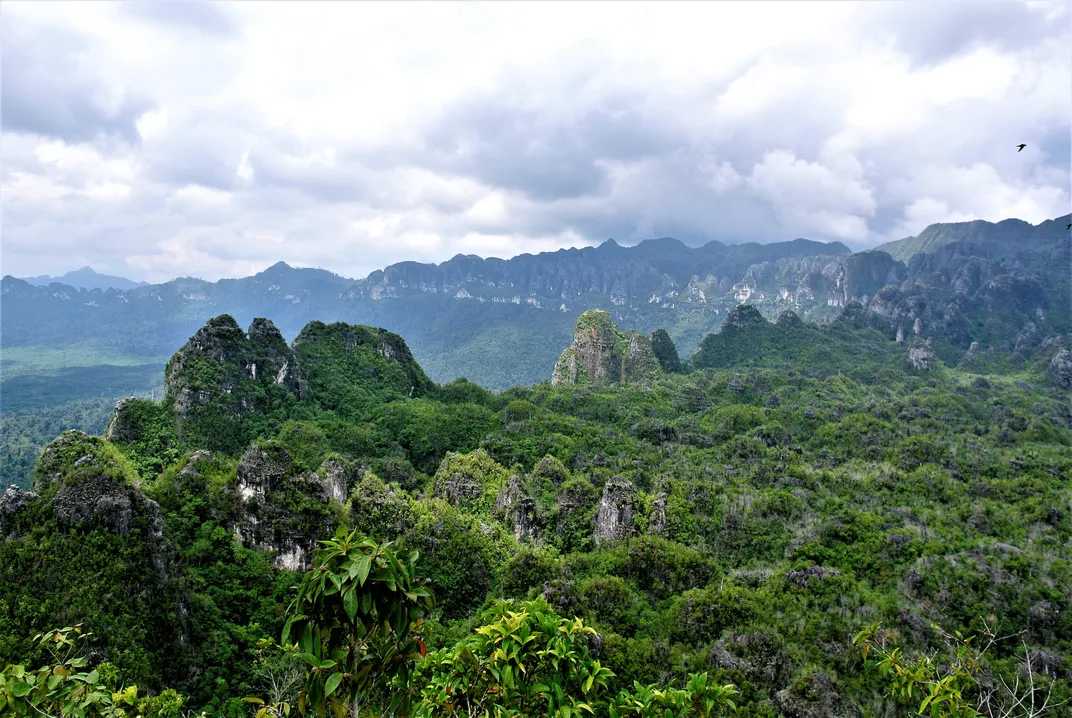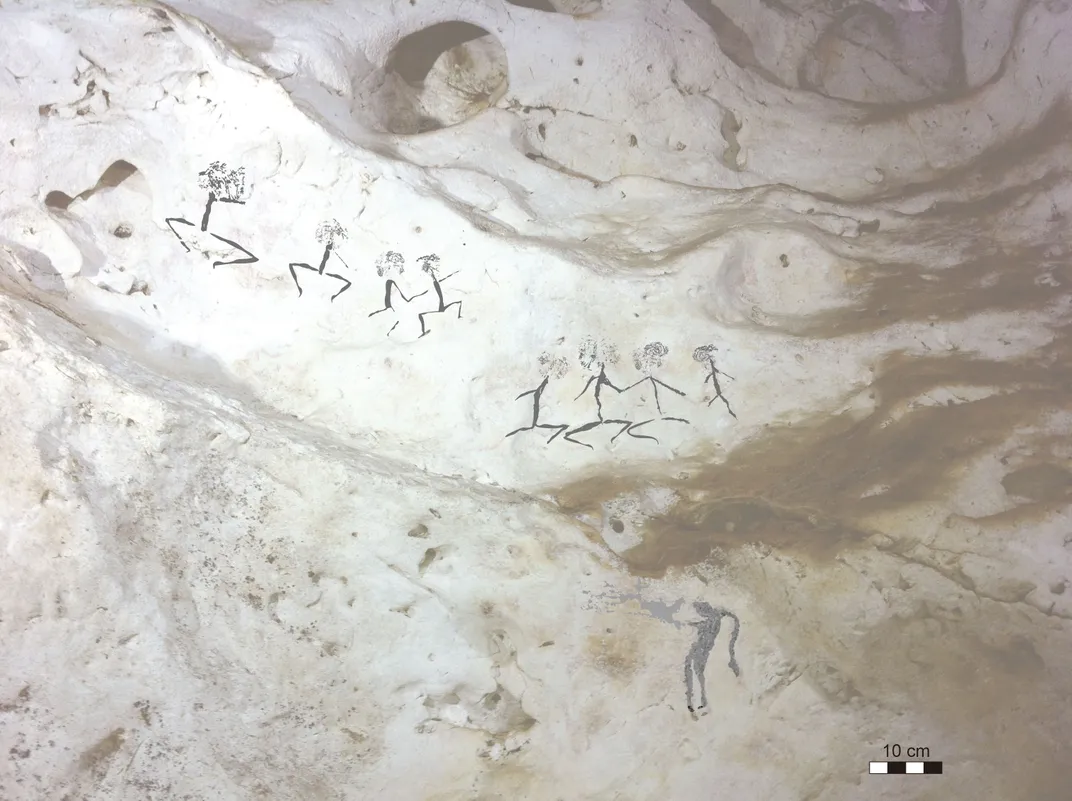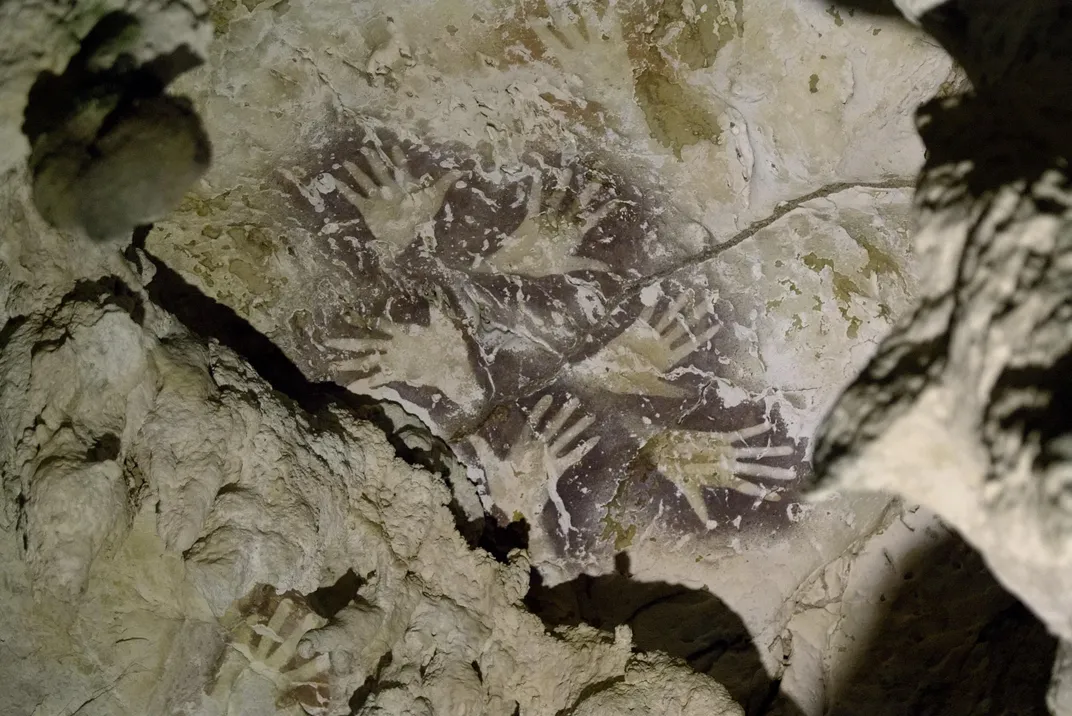World’s Oldest Known Figurative Paintings Discovered in Borneo Cave
Dated to at least 40,000 years old, the depiction of a cattle-like animal has striking similarities to ancient rock art found in other parts of the world
:focal(775x536:776x537)/https://tf-cmsv2-smithsonianmag-media.s3.amazonaws.com/filer/5c/fa/5cfa252c-9b6c-4f25-963b-cd116c1881f5/oldcowpainting.jpg)
Hidden in a remote cave buried in the inaccessible rainforests of Indonesian Borneo, a series of rock art paintings are helping archaeologists and anthropologists to rewrite the history of artistic expression. There, scientists have found, enterprising painters may have been among the very first humans to decorate stone walls with images of the ancient world they inhabited.
The oldest painting in Lubang Jeriji Saléh cave on Borneo, the third-largest island in the world, is a large wild cattle-like beast whose relatives may still roam the local forests. The figure has been dated at 40,000 years old and perhaps older, possibly created about 51,800 years in the past.
These estimates, recently calculated using radiometric dating, may make the painting the oldest known example of figurative cave art—images that depict objects from the real world as opposed to abstract designs. The figures also provide more evidence that an artistic flowering occurred among our ancestors, simultaneously, on opposite ends of the vast Eurasian continent.
Hundreds of ancient images, from abstract designs and hand stencils to animals and human figures, have been documented in Indonesian Borneo’s remote caves since scientists became aware of them in the mid-1990s. But like other signs of ancient human habitation in this part of the world, they are infrequently seen or studied. Borneo’s Sangkulirang–Mangkalihat Peninsula is a land of soaring limestone towers and cliffs, riddled with caves below and blanketed with thick tropical forests above that make travel arduous and have hidden local secrets for thousands of years.

Maxime Aubert, an archaeologist and geochemist at Griffith University, Gold Coast, Australia, says the effort to study the cave paintings was well worth it, not least because of the unique connection one feels here to the distant past.
“When we do archaeological digs, we’re lucky if we can find some pieces of bone or stone tools, and usually you find what people have chucked out,” says Aubert, lead author of a new study detailing the Borneo paintings. “When you look at the rock art, it’s really an intimate thing. It’s a window into the past, and you can see their lives that they depicted. It’s really like they are talking to us from 40,000 years ago.”
The dating of this ancient southeast Asian cave art pens a new chapter in the evolving story of where and when our ancestors started painting their impressions of the outside world. A painted rhino in France’s Chauvet Cave had until recently been the oldest known example of figurative cave art, dated to roughly 35,000 to 39,000 years old. Chauvet and a few other sites led scientists to believe that the birth of such advanced painting had occurred in Europe. But in 2014, Aubert and colleagues announced that cave art depicting stenciled handprints and a large pig-like animal from the same time period had been found on the other side of the world on the Indonesian island of Sulawesi.
“The 2014 paper on Sulawesi made a very big splash, as it showed that cave art was practiced both in Europe and in southeast Asia at about the same time,” Paleolithic archaeologist Wil Roebroeks says in an email. Roebroeks, of Leiden University in the Netherlands, added that Aubert’s team’s research, “killed Eurocentric views on early rock art.”
The Borneo find compliments this earlier work and expands an increasingly broad and intriguing worldview of ancient art—one with as many new questions as answers.
Aubert and colleagues were able to determine when Borneo’s ancient artists plied their trade by dating calcite crusts, known as “cave popcorn,” that seeping water slowly created over the top of the art. The team dated these deposits by measuring the amount of uranium and thorium in the samples. Because uranium decays into thorium at a known rate, uranium series analysis can be used to calculate a sample’s age. And because the paintings lie underneath these crusts, the researchers conclude they must be older than the calcite deposits. Indonesia’s National Research Centre for Archaeology (ARKENAS) and the Bandung Institute of Technology (ITB) also contributed to the study published today in Nature.
/https://tf-cmsv2-smithsonianmag-media.s3.amazonaws.com/filer/a4/d3/a4d38715-df2c-4efe-81f1-61d3a199ca20/banteng-40000-years-old-dated-panel-.jpg)
Even though the uranium dating suggests these figures are the oldest known example of such art in the world, Aubert is even more interested in the striking similarities between the Borneo cave art styles and those found across Europe. In fact, two styles of painting found in Indonesia’s Lubang Jeriji Saléh cave—which were superimposed over one another by peoples who frequented the same cave perhaps 20,000 years apart—also appear at roughly the same times more than 7,000 miles away in Western Europe.
The first style, which began between 52,000 and 40,000 years ago, uses red and orange hues and includes hand stencils and paintings of large animals that lived in the surrounding area. A second distinct style appeared around 20,000 years ago. It uses purple or mulberry colors, and its hand stencils, sometimes linked together by branch-like lines, feature internal decorations.
By 13,600 years ago, the Borneo cave art had undergone another significant evolution—it began depicting the human world. “We see small human figures. They are wearing head dresses, sometimes dancing or hunting, and it’s just amazing,” Aubert says.

“It’s more about a pattern that we can see now. We have really old paintings in Europe and southeast Asia, and not only did they appear at the same time on opposite sides of the world, but it seems that they are evolving at the same time on opposite sides of the world,” Aubert says. “The second distinct style appeared around the time of the last glacial maximum, so it could even be related to the climate. We just don’t know.”
Rock art painters might have developed simultaneously in more than one place, Roebroeks suggests. Alternatively, as he wrote in a 2014 Nature essay, rock art may have been “an integral part of the cultural repertoire of colonizing modern humans, from western Europe to southeast Asia and beyond.”
“We can only speculate about the more or less contemporaneous ‘emergence’ of rock art in western Eurasia and on the other extreme of the distribution of modern humans, Insular South East Asia,” Roebroeks says.
The idea that rock art was an “integral part” of modern human culture from the beginning seems most likely to Durham University archaeologist Paul Pettitt, who says a wide range of evidence supports the interpretation that non-figurative art had evolved in Africa by 75,000 years ago or earlier.
“This could have originated as a way to decorate the body with specific meanings,” he says in an email, “and included shell jewelry known from the north and south of the continent as early as 100,000 years ago.” The artistic expressions “had developed to include the use of red ochre and engraved signs on ochre lumps and stone by 75,000 [years ago] and decoration on ostrich eggshell water containers by 65,000. If we assume this repertoire left Africa with some of the earliest dispersals of Homo sapiens, perhaps on their bodies, it might explain the persistence of a form of art which, by at least 40,000 years ago had come to be extended off of the body, and things closely associated with it, to cave and rock shelter walls,” he says.

But even if we could understand the entire story of early human art, we might still be missing an even bigger picture.
A 2018 study describes Spanish rock art so old that it would have been created more than 20,000 years before modern humans arrived in the region—meaning the artists must have been Neanderthals. Though the dots, lines and hand stencils aren’t the same type of figurative art found in Borneo or Chauvet, the images suggest that artistic expression was part of the Neanderthal toolkit at least 64,000 years ago.
Roebroeks cautions that scientists should hesitate to infer that certain times or places are key to the emergence of a particular cultural behavior, simply because evidence for them is lacking in other eras or locales. As evidenced by the surprisingly old dates recently assigned to the Neanderthal rock art, or the emergence of Pleistocene rock art outside of Europe in Indonesia, these assumptions are often based on the absence of comparable phenomena in neighboring locales or time periods.
Just because we haven’t found them, however, doesn’t mean that they don’t exist. “One of the lessons we can learn from the studies by Aubert and colleagues on rock art from Sulawesi and now Borneo is that such ways of reasoning can be severely flawed.”
Prehistoric art may have been created in the distant past, but the future is likely to bring surprising discoveries that further transform our view of human artistic expression tens of thousands of years after the paint has dried.

